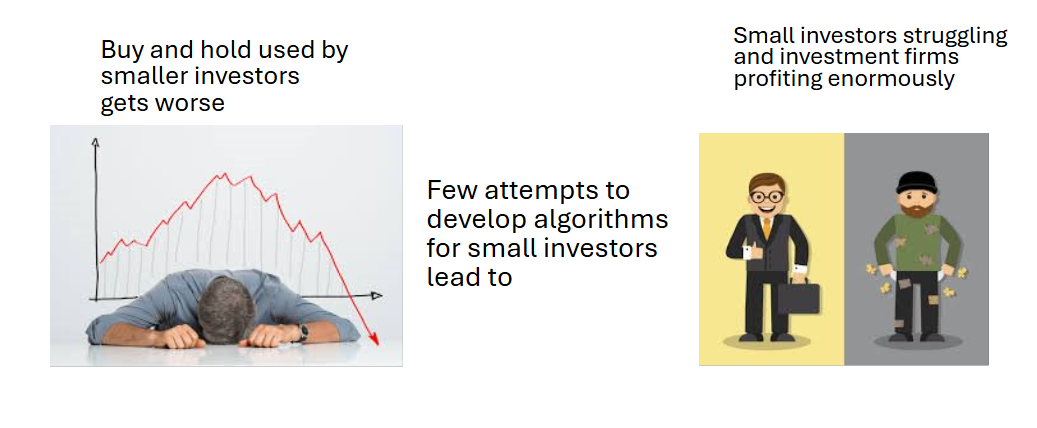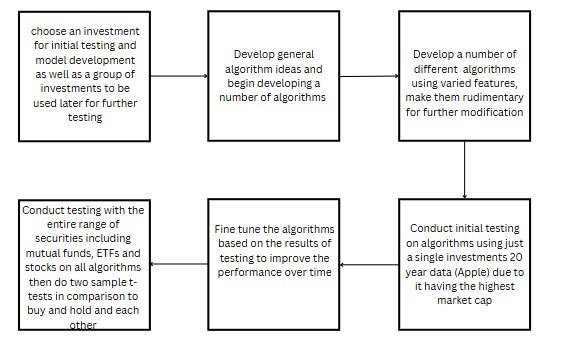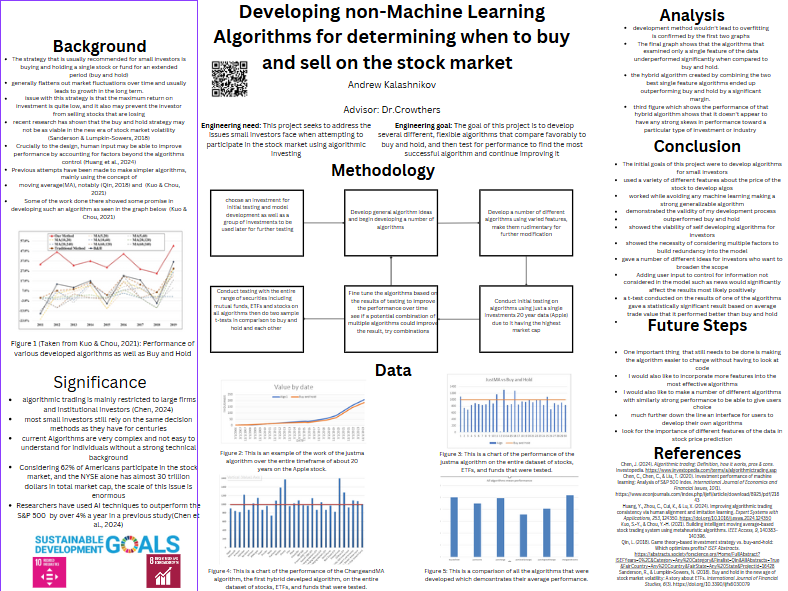Abstract
Graphical Abstract
The stock market is a difficult place to survive for smaller investors, with constant competition
against far larger entities. A particular issue that many smaller investors struggle with is the lack of
access to effective, understandable, and flexible algorithms. In the new age of the stock market where
the largest investors have incredibly complex machine learning algorithms to aid their investing, making
active investment difficult for minor players. To address this issue, I will be attempting to develop an
algorithm geared toward smaller investors that will outperform the basic algorithms available today and
give a chance for smaller investors to participate in the market on a more equal footing. Previously, the
algorithm designed for smaller investors was buy and hold, which has been shown to be flawed by new
research. We will develop algorithms using historical data for testing and attempting different
approaches for algorithm development, including utilizing moving averages and the change in price. So
far, the focus has been on developing very fundamental algorithms, one of which was able to
outperform buy and hold by about 13% over the course of 20 years in initial testing which is an
encouraging sign. The goal is to combine these techniques and others to create algorithms that can be
better than buy and hold by a statistically significant margin over many stocks, ETFs and funds. By
developing this versatile algorithm, we will aid small investors in remaining competitive in today's
market.
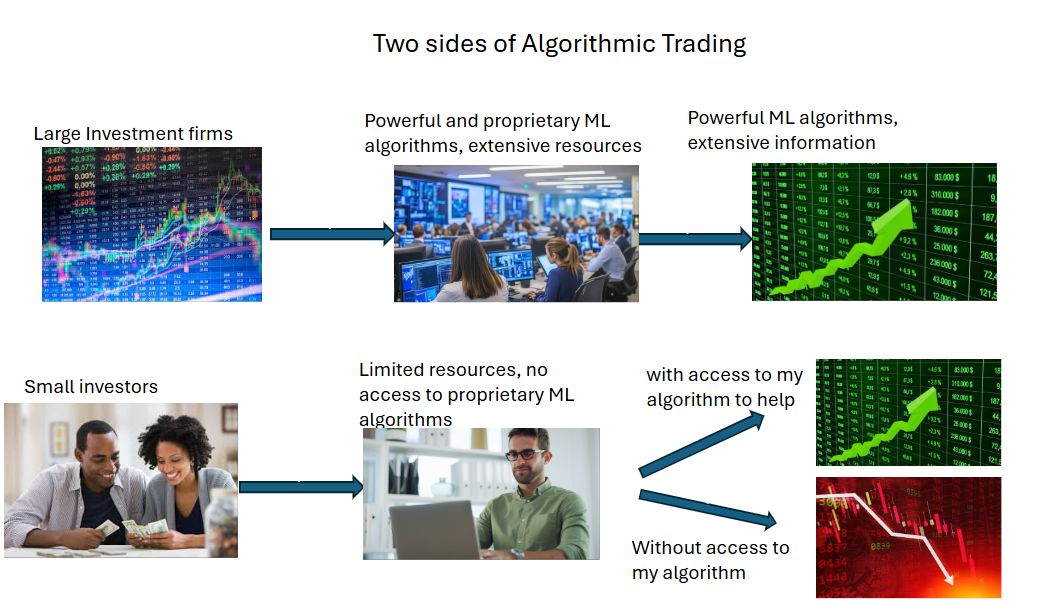
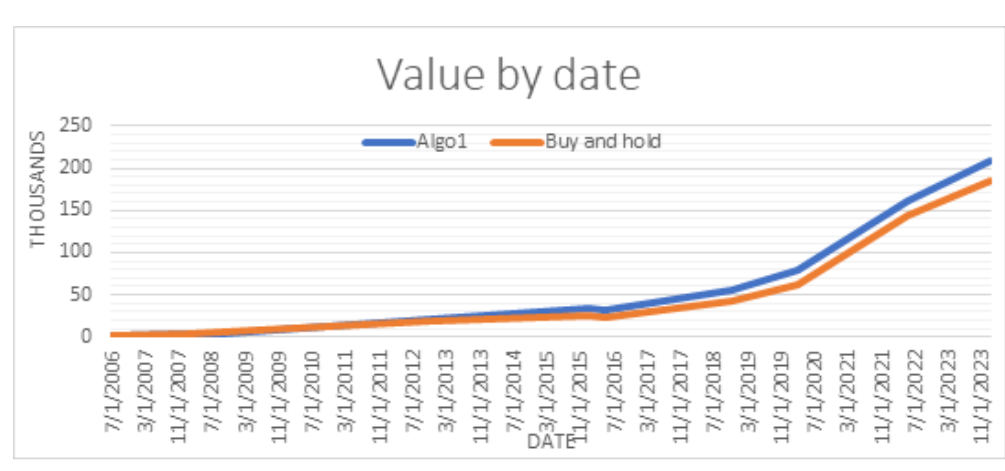
Figure 1: This is an example of the work of the justma algorithm over the entire time frame of about 20 years on the Apple stock.
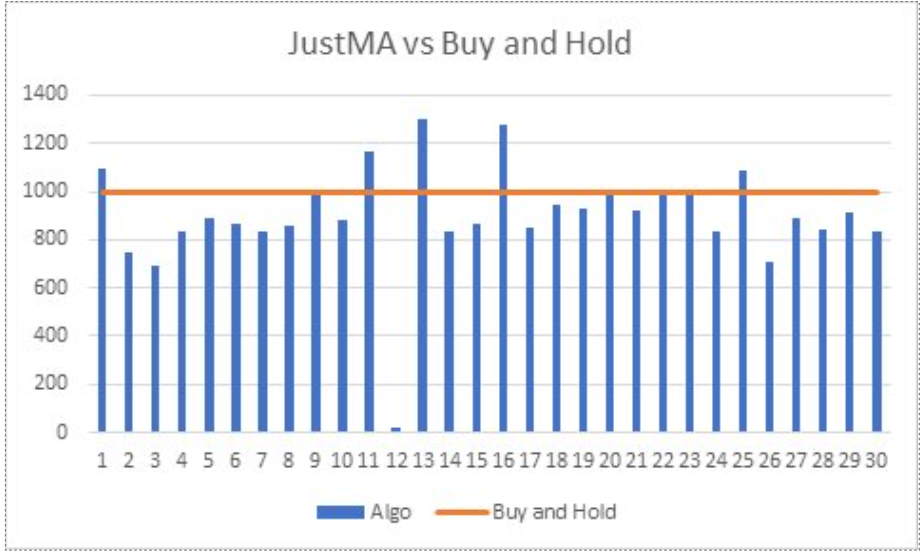
Figure 2: This is a chart of the performance of the justma algorithm on the entire dataset of stocks, ETFs, and funds that were tested.
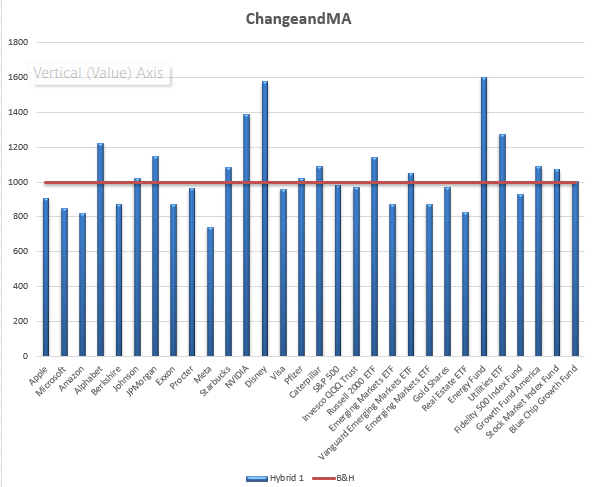
Figure 3: This is a chart of the performance of the ChangeandMA algorithm, the first hybrid developed algorithm, on the entire dataset of stocks, ETFs, and funds that were tested.
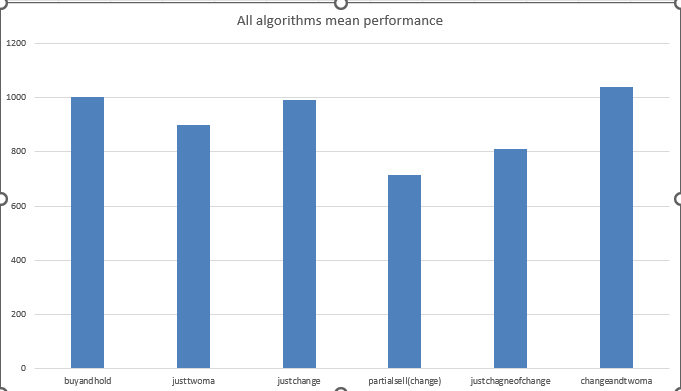
Figure 4: This is a comparison of all the algorithms that were developed which demonstrates their average performance.
Conclusion
The initial goals of this project were to develop algorithms for small investors which were easy to understand, flexible, and were able to outperform buy and hold. This is a crucial issue now more than ever, as the market has become much more perilous
for small investors, with buy and hold no longer as safe of a strategy. To address this issue, I used historical data from some of the highest cap stocks, ETFs and mutual funds to find algorithms that will be able to effectively invest in the market.
I used a variety of different features about the price of the stock, importantly avoiding any machine learning in my work and making a single generalizable algorithm. I feel like my my work has demonstrated the validity of my development process and the fact that
this algorithm can be applied to the current time period with results that won't suffer due to overfitting. More importantly, I was able to develop an algorithm without using machine learning that was easy to understand and flexible, and which outperformed buy and hold.
As much as this project was meant to produce a successful algorithm, it was also meant to show the viability of this kind of algorithm development to encourage others to consider this idea, as well as giving access to a baseline successful algorithm to give small investors
an idea of what might work.
References
Ayyildiz, N., & Iskenderoglu, O. (2024). How effective is machine learning in stock market predictions? Heliyon, 10(2). https://doi.org/10.1016/j.heliyon.2024.e24123
Chen, J. (2024). Algorithmic trading: Definition, how it works, pros & cons. Investopedia. https://www.investopedia.com/terms/a/algorithmictrading.asp
Chen, C., Chen, C., & Liu, T. (2020). Investment performance of machine learning: Analysis of S&P 500 Index. International Journal of Economics and Financial Issues, 10(1). https://www.econjournals.com/index.php/ijefi/article/download/8925/pdf/21843
Huang, W., Satoru, G., & Nakamura, M. (2021). Decision-making for stock trading based on trading probability by considering whole market movement. European Journal of Operational Research, 157(1), 227-241. https://doi.org/10.1016/S0377-2217(03)00144-9
Huang, Y., Zhou, C., Cui, K., & Lu, X. (2024). Improving algorithmic trading consistency via human alignment and imitation learning. Expert Systems with Applications, 253, 124350. https://doi.org/10.1016/j.eswa.2024.124350
Kuo, S.-Y., & Chou, Y.-H. (2021). Building intelligent moving average-based stock trading system using metaheuristic algorithms. IEEE Access, 9, 140383-140396. https://doi.org/10.1109/ACCESS.2021.3119041
Ling, F., Ng, D., & Muhamad, R. (2014). An empirical re-investigation on the 'buy-and-hold strategy' in four Asian markets: A 20 years' study. World Applied Sciences Journal, 30(30). https://doi.org/10.5829/idosi.wasj.2014.30.icmrp.30
Picardo, E. (2024). Investing explained: Types of investments and how to get started. Investopedia. https://www.investopedia.com/terms/i/investing.asp
Qin, L. (2018). Game theory-based investment strategy vs. buy-and-hold: Which optimizes profits? ISEF Abstracts. https://abstracts.societyforscience.org/Home/FullAbstract?ISEFYears=0%2C&Category=Any%20Category&Finalist=Qin&AllAbstracts=True&FairCountry=Any%20Country&FairState=Any%20State&ProjectId=16428
Saez, E., & Zucman, G. (2020). The rise of income and wealth inequality in America: Evidence from distributional macroeconomic accounts. Journal of Economic Perspectives, 34(4), 3-26. https://doi.org/10.1257/jep.34.4.3
Sakhare, A., Mhaskar, N., Mishra, V., & Chavan, M. (2021). Algorithmic trading for a buy-sell platform: Study and comparison. ITM Web of Conferences, 40, 03020. https://doi.org/10.1051/itmconf/20214003020
Sanderson, R., & Lumpkin-Sowers, N. (2018). Buy and hold in the new age of stock market volatility: A story about ETFs. International Journal of Financial Studies, 6(3). https://doi.org/10.3390/ijfs6030079
Sikalo, M., Arnaut-Berilo, A., & Zaimovic, A. (2022). Efficient asset allocation: Application of game theory-based model for superior performance. International Journal of Financial Studies, 10(1), 20. https://doi.org/10.3390/ijfs10010020
Sobolev, D., Chan, B., & Harvey, N. (2017). Buy, sell, or hold? A sense-making account of factors influencing trading decisions. Cogent Economics & Finance, 5. https://doi.org/10.1080/23322039.2017.1295618
Taylor, B. (2024). 5 key investment strategies to learn before trading. Investopedia. https://www.investopedia.com/investing/investing-strategies/

